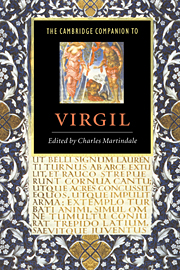Book contents
- Frontmatter
- Contents
- List of illustrations
- List of contributors
- Preface
- 1 Introduction: ‘The classic of all Europe’
- Part 1 Translation and reception
- Part 2 Genre and poetic career
- 8 Green politics: the Eclogues
- 9 Virgilian didaxis: value and meaning in the Georgics
- 10 Virgilian epic
- 11 Closure: the Book of Virgil
- Part 3 Contexts of production
- Part 4 Contents and forms
- Dateline compiled by Genevieve Liveley
- List of works cited
- Index
- Plates
10 - Virgilian epic
from Part 2 - Genre and poetic career
Published online by Cambridge University Press: 28 May 2006
- Frontmatter
- Contents
- List of illustrations
- List of contributors
- Preface
- 1 Introduction: ‘The classic of all Europe’
- Part 1 Translation and reception
- Part 2 Genre and poetic career
- 8 Green politics: the Eclogues
- 9 Virgilian didaxis: value and meaning in the Georgics
- 10 Virgilian epic
- 11 Closure: the Book of Virgil
- Part 3 Contexts of production
- Part 4 Contents and forms
- Dateline compiled by Genevieve Liveley
- List of works cited
- Index
- Plates
Summary
In retrospect, the career of Virgil seems to trace out an inevitable progression. Working within a tradition which defined poetry composed in dactylic hexameter verse as epos (connoting 'word' or 'utterance'), the poet of the Eclogues, through the figure of the shepherd-singer Tityrus, recalls how his earliest poetic production involved a rejection of martial themes (reges et proelia, 'kings and battles', Eel. 6.3) in favour of a pastoral mode, avowedly lowly and humble (cf. EcL 4.1-2), which looked back to the 'Syracusan verse' of Theocritus (EcL 6.1-2). Taking leave of this mode at the end of the final poem of the collection, the shepherd-singer, in his characteristic pose recumbent in the shade of a tree, announces his intention to rise (surgamus, EcL 10.75), presaging the composition of the Hesiodic Georgics. He thereby attributes to that poem a more elevated stylistic level, reiterates a hierarchy within the received types of epos, and begins to map an upward trajectory through those types on to the poet's life-cycle. In the opening lines of the Third Georgic, a further move upwards is envisaged (G. 3.8-9):
temptanda via est, qua me quoque possim tollere humo victor que virum volitare per or a.
I must attempt a way, whereby I too may raise myself from the ground and victorious fly through the mouths of men.
- Type
- Chapter
- Information
- The Cambridge Companion to Virgil , pp. 145 - 154Publisher: Cambridge University PressPrint publication year: 1997
- 4
- Cited by



